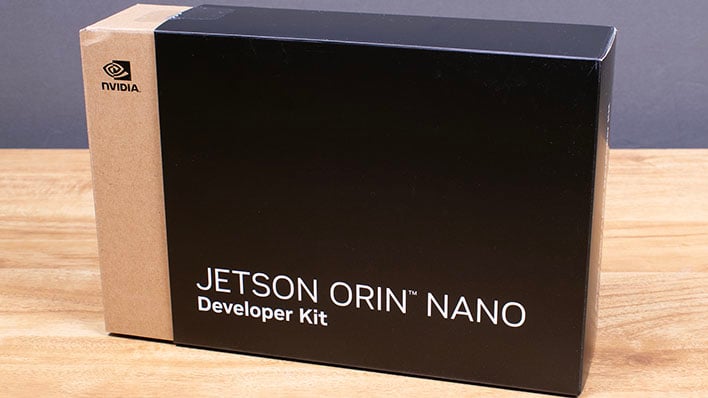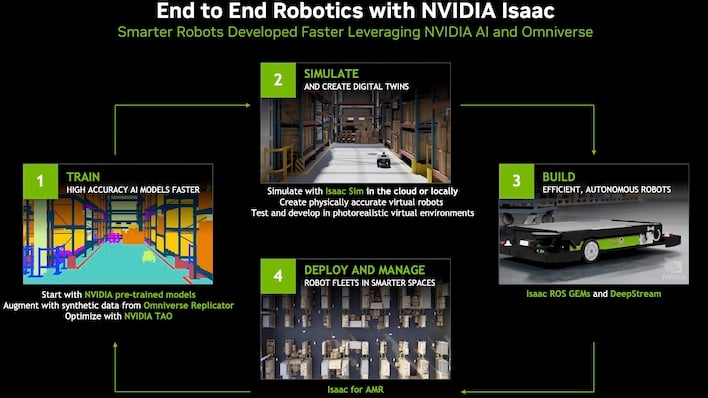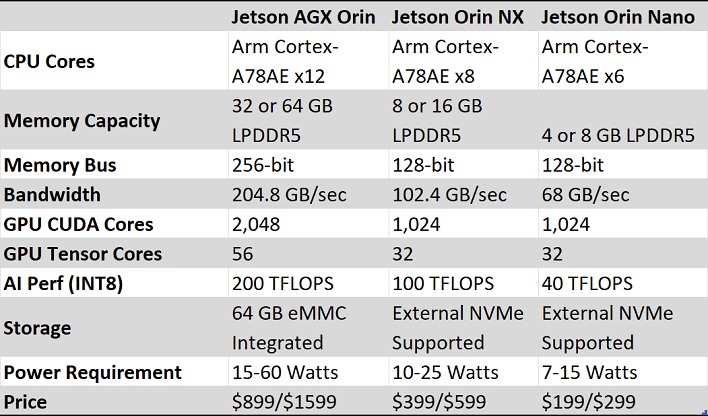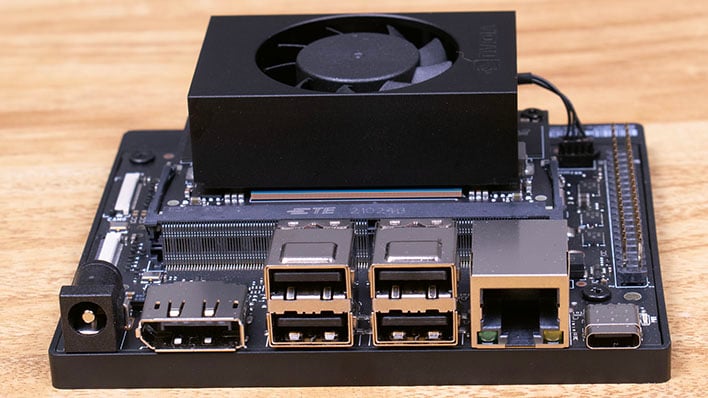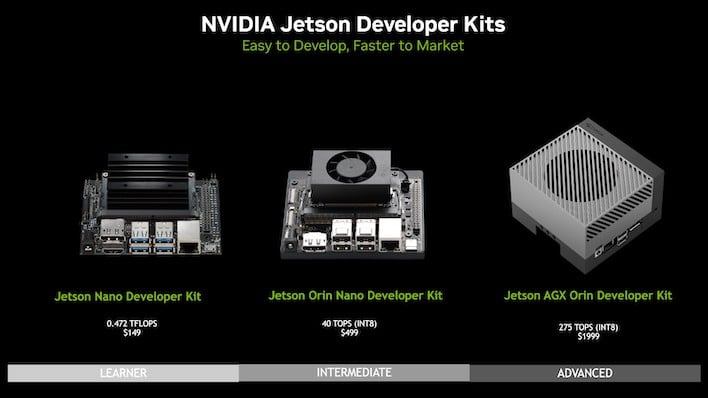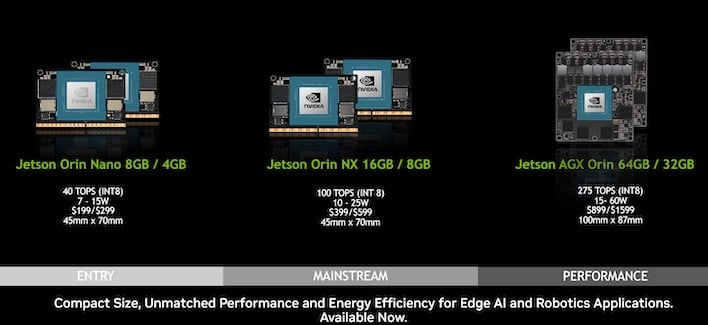Exploring NVIDIA Jetson Orin Nano: AI And Robotics In The Palm Of Your Hand
NVIDIA Jetson Orin Nano Developer Kit: Powerful, Affordable AI Edge Computing In A Small Package
| NVIDIA Jetson Orin Nano: Starting At $199 (4GB), $299 (8GB) The new NVIDIA Jetson Orin Nano Developer Kit offers a massive performance boost over the previous generation, at an affordable price point.
|
|||

|

|
||
NVIDIA is announcing new software and hardware for its AI development efforts at its GTC developer conference, which is currently underway. At this time last year the company gave us a chance to look at its flagship AI edge developer kit, the Jetson AGX Orin. That $2,000 AI and robotics platform was a truly impressive piece of kit, with tons of performance, a compact size, and manageable power profile. This year, the company is scaling down its high-end compute platform to fit an even smaller target with the Jetson Orin Nano Developer Kit, which we're going to feature here today. As its branding implies, this developer unit is based on the Jetson Orin Nano, which NVIDIA announced back in September.
Jetson Orin Nano Developer Kit: Target Audience vs. Competitors
To go along with some shiny new hardware, NVIDIA has also taken the wraps off a massive update for the JetPack Software Development Kit (SDK) that brings new capabilities and a rather hefty performance uplift to all of its Orin devices. Between the scaled-up hardware capabilities and a more optimized software experience, NVIDIA promises the Jetson Orin Nano dev kit is more than twice as fast than the previous-generation Jetson Xavier, and a whopping eighty (yes, that's 80) times faster than the Jetson Nano in AI-focused tasks -- specifically a leap from 0.47 to 40 8-bit integer (INT8) TOPS. Performance in 32-bit floating point calculations is "only" 5.4 the Jetson Nano's performance, but regardless, it's a huge jump in capabilities paired with a similar power draw, resulting in very large gains in absolute performance and performance per Watt.As mentioned, this developer kit is based on the new Jetson Orin Nano, which is built on the same technology as the Jetson AGX Orin Developer Kit, but scaled down for a lower power envelope and a lower price point. Much of the performance delta between this new Nano and the previous version has to do with the presence of Tensor cores in the Jetson Orin Nano's GPU, whereas the Maxwell-based Jetson Nano had none. These days, the original Jetson Nano, which has a trimmed down version of the Tegra X1 found in the Nintendo Switch, is a fine educational tool at a very low price point. But considering its lack of dedicated AI hardware and limited memory, the previous generation is just not suitable for working on today's AI models with huge datasets, and that's where Jetson Orin Nano comes in.
One important thing to note is that this is a very different kind of platform than the AMD Xilinx KR260 Robotics Starter Kit we just looked at. The Jetson Orin Nano is focused on machine learning for edge AI and robotics through NVIDIA's accelerated computing technology, whereas the KR260 is for industrial robotics and features a different set of IO, and relies on FPGA technology. In terms of onboard connectivity we could draw a somewhat closer parallel with the (very similar) KV260 AI Vision Starter Kit, which does share a similar target audience for image and video processing and recognition, again with an FPGA. The prices for production modules are also quite similar. The AMD Xilinx K26 is a pretty well-established product at this point, whereas the Jetson Orin Nano is brand new, and in NVIDIA's view represents a step up in value compared to the existing market. We'll definitely have more to say about that later on, so stay tuned.
Before we dive into the hardware, though, let's take a look at where the JetPack SDK has gone over the previous twelve months.
NVIDIA's JetPack SDK Takes Off
Since the introduction of JetPack 5.0 back in April of 2022, NVIDIA has been hard at work improving the performance of its machine learning tools. NVIDIA has been touting the Jetson Orin Nano's 80x advantage in machine learning over the original Jetson Nano, but as we mentioned the original doesn't have Tensor cores. As a result, that kind of huge performance leap shouldn't be totally unexpected. Still, quite a bit of that is directly attributed to the software that runs underneath: Jetpack version 5.1.Despite what looks like a modest version increment from 5.0, the latest version of JetPack has been highly optimized over the last 12 months to wring an additional 54% performance increase in AI-focused tasks. Today we're looking at a preview version of the toolkit, but NVIDIA says that it's not done, and fully expects additional improvements to JetPack over the coming months. And in fact, if you've been writing software on the NVIDIA platform, you've probably already experienced these speedups. JetPack 5.1.0 added support for the Jetson Orin NX 16GB back in January, according to NVIDIA's documentation.
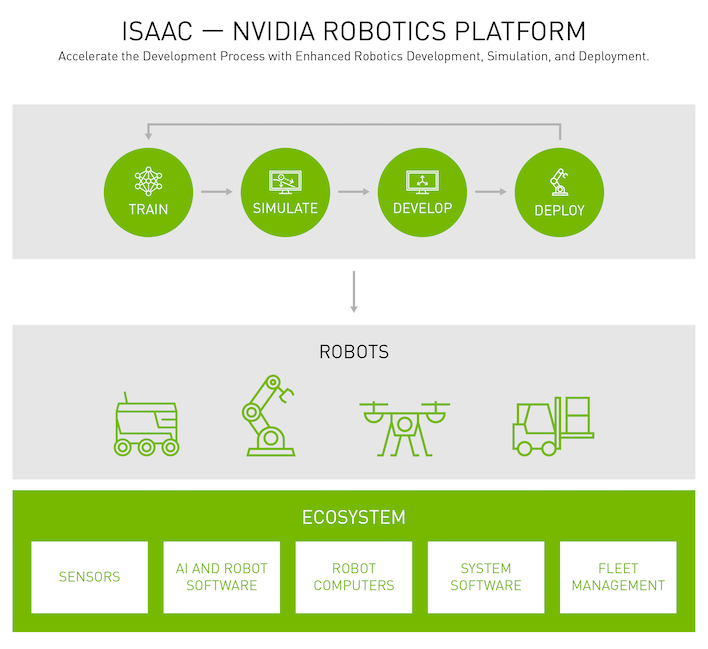
JetPack is a comprehensive suite of libraries and APIs that let developers forgo manually writing software to directly address Tensor cores or the GPU and get right to training and inferring. It's also a robotics platform that encompasses the entire robotics stack, built upon Robot OS 2 (or ROS 2 for short). NVIDIA calls the robotics platform Isaac, and it encompasses every step of the process from training AI models and simulating builds to deploying production units and fleet management. As part of our demo today, NVIDIA gave us a taste of the model training and optimization process using computer-generated content and we'll be able to see how better optimized a model is once it's received extra training.
While none of these concepts are particularly new, since the company has been pushing them for quite a while, NVIDIA has sti;; been hard at work and all of the tools from version 5 have been updated. The SDK includes tools for image classification and segmentation, neural network support, camera and vision APIs, the latest version of Vulkan, and a whole lot more. We're going to demonstrate some of the fruits of that labor shortly when we dig into the Jetson Orin Nano Developer Kit. So, without further ado, let's take a look at the hardware...
Introducing the Jetson Orin Nano Developer Kit
Here is the Jetson Orin Nano Developer Kit. This little system looks much more like the $60 Jetson Nano 2GB we looked at a while back than the Jetson AGX Orin Developer Kit. Looks can be deceiving, however, and as we touched on earlier, NVIDIA has beefed up this hardware in a big way. It's more helpful to compare this kit to its big sibling, as they're both based on the same technology. This developer kit is based on the Jetson Orin Nano, which NVIDIA announced back in September. We've built a table above that covers the basics, so let's get to comparing.
The biggest differences are in the enabled resources on the SoM, and then of course the price point. Whereas the Jetson AGX Orin Developer Kit has 12 Arm64 Cortex-A78AE cores, 32GB of LPDDR5 memory with 204GB/s of memory bandwidth, and a 2048-core Ampere-based GPU, the Jetson Orin Nano trims everything down. We have no doubt that the Jetson Orin Nano has enough resources for its intended audience, however, and it's about half of everything, with one key exception. Six Cortex-A78AE cores and 1024 CUDA cores are exactly 50% of its larger sibling. The 8GB of LPDDR5 memory is just a quarter of the capacity though, and the lower speed plus reduced bus width give it exactly one-third the effective bandwidth at 68GB/s.
Of course, that has some advantages, as well; the Jetson Orin Nano has a thermal budget of either 7 Watts or up to 15 Watts, so it just sips power. There's also no eMMC storage on the lower-priced variant, where the AGX Orin variant has 64 GB of onboard storage with Linux preinstalled. Instead, we'll have to get by on a micro SD card, which NVIDIA provided pre-flashed with the Jetson 5.1.1 preview. That's no different than other low-cost development platforms, whether FPGA devices like the Terasic DE10-nano found in (among other things) the MiSTer FPGA project, or AMD Xilinx K26 platforms like the KV260 or KR260 starter kits. That's also true of other Arm64-based machines like the (cheaper but much weaker, and still pretty scarce) Raspberry Pi 4.
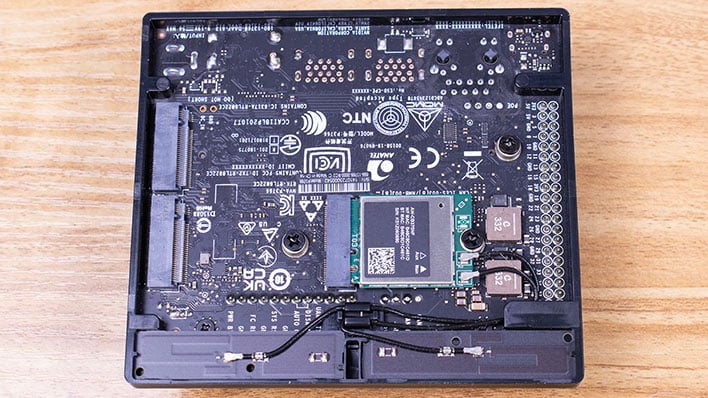
The rest of the NVIDIA Jetson Orin Nano Developer Kit includes the carrier board, which has enough IO to do just about anything that JetPack supports. There are four USB 3.0 ports, a DisplayPort 1.4 video output, USB 3.1 Gen 1 Type-C (which also carries video via DP Alt Mode), a 40-pin GPIO pin array, and a pair of 22-pin ribbon cable camera connections. Network connectivity comes in the form of wired Gigabit Ethernet along with 802.11ac Wi-FI and Bluetooth 5.0 integrated into the board, with antennas on the bottom side of the unit. There's even a pair of M.2 ports suitable for NVMe SSDs either 80 or 30 millimeters in length, but we're using the SoM's integrated SD card port today. Notably absent is an HDMI port of any kind, but NVIDIA correctly points out that DisplayPort to HDMI adapters are pretty cheap, if needed. Power is provided by a 19v barrel jack, and NVIDIA includes a 45-Watt AC adapter in the box with the Developer Kit.
Jetson Orin Family Lineup
We should also mention that there are several production modules available for purchase starting today, as well. Six production modules will be available in total, along with the three development platforms we've covered previously or are looking at today.Starting at the bottom, below all of the Orin models, is the previous-gen Jetson Nano developer kit, which will stick around in just its 4GB version. That model hasn't wavered from its $149 price point as an entry-level platform for education. It's definitely enough horsepower to prove out development work, but large models require lots of RAM, which that model lacks, and its Maxwell-based GPU lacks Tensor cores. Because of those limitations, everyone else will probably want these models with AI acceleration.
There are now six members of the Orin family, the lowest of which is what we're looking at today. The Jetson Orin Nano production module, upon which this kit is based, is available in 4GB and 8GB models priced at $199 or $299, respectively. If we compare the $299 price of the 8GB Nano to the $499 price of the Jetson Orin Nano Developer Kit, we see that the extras add about $200 to the total cost, which seems pretty reasonable. All of the Developer Kits are available directly from NVIDIA's Jetson store starting today. The 8GB production module, as well as the Developer Kit, has a 40 TOPS rating for machine learning tasks, which as we mentioned, the company says is 80 times the speed of the previous Jetson Nano. The 4GB module does trim that back to 20 TOPS, but that's still a considerable jump over the last generation.
In the middle, the Jetson Orin NX replaces the Xavier NX in 8GB and 16GB versions. These have configurable TDPs of 10 to 25 Watts, a full 102GB/s of memory bandwidth, and an Ampere-based GPU with 1,024 CUDA cores and 32 Tensor cores. Because of the doubled Tensor core budget and a higher thermal headroom, the machine learning power reaches 100 TOPs. These will be priced accordingly, at $399 for the 8GB model and $599 for the 16GB version. The 16GB version has been available for a while at $699, so it's getting a price cut. The 8GB model is new, as is its lower price point. Like the Orin Nano, the lower-memory version has a trimmed back performance figure of 70 TOPS to the 16GB version's 100 TOPS rating. There won't be a developer kit based on Jetson Orin NX, but the Jetson AGX Orin Developer Kit has built-in modes for simulating the resources and thermal budget, so it can target these more expensive models directly. Additionally, the same carrier board that the Jetson Orin Nano Developer Kit includes can be used for the Jetson Orin NX production module to take the form of a developer kit.
Lastly, at the top end, we have the 32GB and 64GB versions of the Jetson AGX Orin. These have the exact same 2,048-core GPU with 56 Tensor cores, 204GB of LPDDR5 memory, and 64GB of eMMC as the Developer Kit. The AGX Orin Developer Kit and the 64GB production module both have 12 CPU Arm Cortex-A78AE cores, whereas the 32GB production module has eight cores. Regardless, the thermal and power requirements haven't changed from a maximum of 60 Watts, and neither has the 275 TOPS of inferencing horsepower. The 32GB model has been available at $999, but will have its price dropped to $899. The new 64 GB version will be priced at $1,599.
Now it's time to dig into the Jetson Orin Nano and figure out what it can do. Hang tight, because next up we're going to take this puppy for a spin and check out some AI workloads on this pint-sized machine learning powerhouse...

